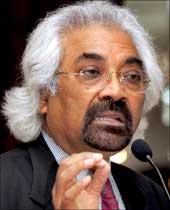 Prime Minister Manmohan Singh [ Images ] on Tuesday approved the setting up of a National Innovation Council to prepare a road map for the 'Decade of Innovation 2011-2020'.
Prime Minister Manmohan Singh [ Images ] on Tuesday approved the setting up of a National Innovation Council to prepare a road map for the 'Decade of Innovation 2011-2020'.Sam Pitroda [ Images ], adviser to the prime minister on public information infrastructure and innovations, will head the National Innovation Council.
The Council has been given the mandate to evolve an Indian model of innovation focussing on inclusive growth and creating an appropriate ecosystem conducive to fostering inclusive innovation.
It will delineate appropriate policy initiatives within the government required to spur innovation. It will also promote the setting up of sectoral innovation councils and state innovation councils.
While encouraging all important sectors of the economy to innovate, the NIC will take special efforts to facilitate innovation by micro, small and medium enterprises.
Innovation in public services delivery and encouraging multi-disciplinary and globally competitive approaches for innovations would be focused on by the council.
The National Innovation Council would have as its members:
- K Kasturirangan, members of the Planning Commission;
- Arun Maira, member of the Planning Commission;
- Ramesh A Mashelkar, former director general of CSIR;
- Kiran Karnik, former President, Nasscom;
- Devi Prasad Shetty of the Narayana Hrudyalaya;
- R Gopalakrishnan, executive director, Tata Sons;
- Kiran Mazumdar Shaw, chairperson, Biocon [ Get Quote ];
- Shekhar Kapur [ Images ], film director;
- Saurabh Srivastava, chairman, CA Technologies;
- Anil K Gupta, professor IIM Ahmedabad [ Images ];
- Sujatha Ramadorai, professor, TIFR;
- Chandrajit Banerjee, director general, CII;
- Amit Mitra, secretary general, FICCI;
- Samir Brahmachari, director general, CSIR; and
- Sanjay Dhande, director, IIT Kanpur [ Images ].
By providing public access to telephones, Mr. Sam Pitroda revolutionized the state of telecommunications in India. Currently, Mr. Pitroda is the Chairman and CEO of World-Tel Limited, an International Telecom Union (ITU) initiative. He is also the Chairman and Founder of Sevend high-technology. Sam Pitroda is also the founding Chairman of a non-profit Foundation for' Revitalization of Local Health Traditions in India. As a result of his pioneering works, Sam Pitroda holds more than 50 patents and has lectured extensively on Telecom, Technology and Development, in almost all parts of the world. Sam Pitroda has also featured in several newspapers, magazines, radio and TV programs.
Background
Satyanarayan Gangarm Pitroda, better known as Sam Pitroda was born in Titlagarh, Orissa, India. Sam Pitroda did his schooling at Anand Vallabh Vidyalaya in Gujarat and Masters in Physics and Electronics in Baroda. In the year1964, Sam Pitroda went to the US and did his Masters in Electrical Engineering in Chicago. Thereafter he worked at GTE and formed Wescom Switching, Inc. In the year 1984, Sam Pitroda returned to India and founded the Center for Development of Telematics (CDAC) and later became advisor to the PM of India on National Technology Missions. Mr. Pitroda lives in Chicago, Illinois with his wife Anu, son Salil and daughter R central for development of telematics
The Centre for Development of Telematics (C-DOT) is the Telecom Technology development centre of the Government of India. It was established in August 1984 as an autonomous body. It was vested with full authority and total flexibility to develop state-of-the-art telecommunication technology to meet the needs of the Indian telecommunication network. The key objective was to build a centre for excellence in the area of telecom technology.
While the initial mandate of C-DOT in 1984 was to design and develop digital exchanges and facilitate their large scale manufacture by the Indian Industry, the development of transmission equipment was also added to its scope of work in 1989.
electronic wallet
 Chandrasekhara Venkata Raman was born at Trichinopoly in Southern India on November 7th, 1888. His father was a lecturer in mathematics and physics so that from the first he was immersed in an academic atmosphere. He entered Presidency College, Madras, in 1902, and in 1904 passed his B.A. examination, winning the first place and the gold medal in physics; in 1907 he gained his M.A. degree, obtaining the highest distinctions.
Chandrasekhara Venkata Raman was born at Trichinopoly in Southern India on November 7th, 1888. His father was a lecturer in mathematics and physics so that from the first he was immersed in an academic atmosphere. He entered Presidency College, Madras, in 1902, and in 1904 passed his B.A. examination, winning the first place and the gold medal in physics; in 1907 he gained his M.A. degree, obtaining the highest distinctions.